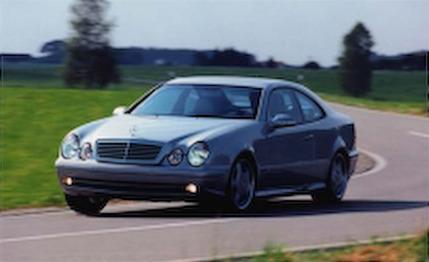
 First Drive Review
First Drive Review
There's always something reassuring about the introduction of a high-performance car when it takes place at a racetrack. Not only does it reveal that the maker has confidence in the car's ability to perform under extreme conditions, but it also suggests that the manufacturer is comfortable with the track environment -- a state of mind that usually results from extensive experience with racing.
Both suspicions were confirmed during our drive of three new Mercedes AMG models at Germany's Hockenheim racetrack. Headquartered in Affalterbach, AMG is located almost exactly halfway between Mercedes headquarters in Stuttgart and the track at the outskirts of Hockenheim.
Mercedes offers AMG editions of every one of its product lines in Germany, including station-wagon versions of the C- and E-class models. But exports to America are currently limited to the E55 sedan and the ML55 sport-ute.
Next year, AMG will add three new models -- the CLK55, the S55, and the CL55. In the usual AMG fashion, the alphabetical part of the designation signifies the model line and the 55 indicates that there's a 5429cc V-8 underhood.
Of these, the CLK55 is easily the most interesting, as it will likely be the quickest AMG model ever sold in America. Equipped with essentially the same engine as the E55 -- with 342 horses instead of 349, due to a tighter exhaust system -- and about 300 fewer pounds, the CLK will reportedly rip to 60 mph in just under five seconds flat.
As is typical with the AMG models, the CLK55 receives numerous other performance enhancements to complement the powerful hand-built-by-AMG V-8, which is 67 horses racier than the engine in the CLK430. The five-speed automatic transmission is based on the heavy-duty gearbox used in the V-12 S-class models. And it is coupled to a reinforced differential with a beefy driveshaft four inches in diameter.
Larger-diameter and thicker vented brake rotors, squeezed by twin-piston calipers, increase stopping ability to match the power boost. The springs, shocks, and anti-roll bars are also firmer, but interestingly enough, wheel and tire sizes are the same as on the CLK430, which is already equipped with 17-inch AMG wheels -- 7.5 inches wide in front and 8.5 inches in the rear. From the standpoint of creature comforts, the CLK55 comes fully equipped. The only options are a navigation system and a mobile phone.
On the track, the AMG CLK was agile, responsive, and extremely quick. Its steering is so linear that you carve your desired lines through the corners precisely without need for great concentration and constant corrections. As expected with the AMG-upgraded brakes, stopping power is strong and fade-free, although the pedal feel was softer than we prefer.
The CLK55 retains the Mercedes electronic stability program (ESP), which combines the functions of traction control and stability control; you can drive the car to about 7/10ths with these systems engaged. Go quicker than that, and the ESP becomes intrusive; so you'll want to hit the ESP button, which turns off the traction-control function. In this mode, handling remains neutral, but you can use the engine's 376 pound-feet of torque to slide the tail in controllable fashion. Indeed, it rained during our track session, and the CLK proved very easy to drift around the soaked course. Our only complaint in the rain was the inability of the "Touch Shift" five-speed manumatic transmission to hold a gear. Although the manual shift gate facilitates easy gear selection, the programming still allows the transmission to kick down when you floor the throttle. As a result, you can't hold a higher gear to help preserve traction in the rain.
Off the track, the CLK55 remains as practical as its less powerful stablemates. The rear seat is large enough for adults during short urban trips. The trunk space is generous, and the interior is comfortable and well finished.
All versions of the CLK, however, are still based on the old C-class platform rather than the one used for the new C-class sedan. That means that the CLK's steering column lacks the tilt adjustment of the newer platform, which it needs to lower the rather high-positioned steering wheel.